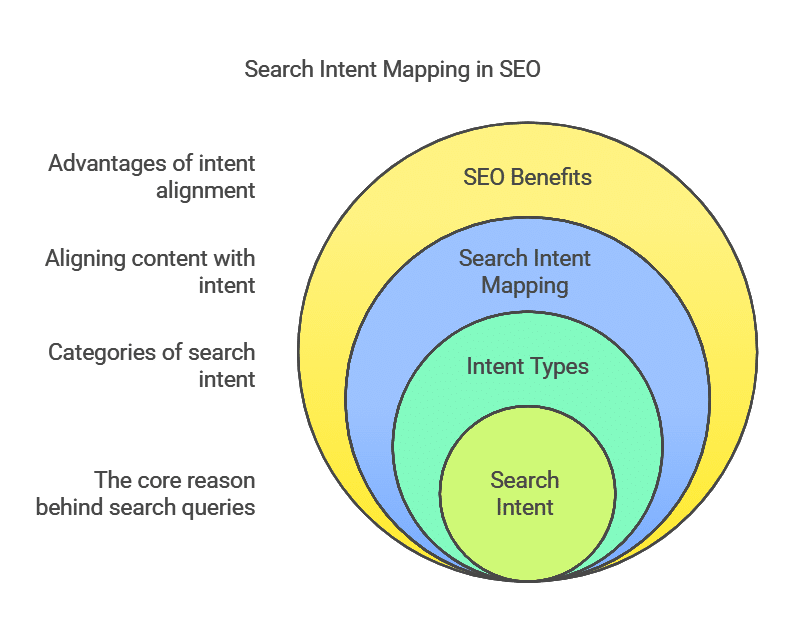Understanding Search Intent Mapping
Search intent mapping is a crucial process in SEO that involves analysing and categorising search queries to align content with user expectations. Users enter queries with specific goals in mind. Businesses must identify these goals to deliver relevant results.
Matching content with search intent improves engagement and conversions.
In multilingual SEO, search intent becomes even more complex.
Direct translations of keywords often fail to capture regional and cultural differences in user behaviour.
Understanding and adapting to these variations ensures that content resonates with diverse audiences across different markets.
Understanding Search Intent
Search intent refers to the reason behind a user’s search query. There are four main types:
- Informational: Users seek knowledge or answers to specific questions (e.g., “What is search intent?”).
- Navigational: Users look for a particular website or brand (e.g., “Google Search Console”).
- Commercial: Users research products or services before making a purchase decision (e.g., “Best multilingual SEO tools”).
- Transactional: Users are ready to take action, such as making a purchase (e.g., “Buy keyword research software”).
Accurately identifying search intent allows businesses to optimise their content, improving user satisfaction and search rankings.
The Process of Search Intent Mapping
To align content with search intent, follow these steps:
- Keyword Research: Identify search terms relevant to your audience using tools like Google Keyword Planner, Ahrefs, and SEMrush.
- Analyse SERPs: Examine the top-ranking results for your target keywords to determine the dominant intent.
- Categorise Intent: Classify keywords based on the four main intent types.
- Content Alignment: Adapt existing content or create new material that meets user expectations.
- Monitor Performance: Continuously assess engagement metrics and refine content strategies accordingly.
Why Search Intent Mapping Matters in SEO
Search engines prioritise user satisfaction. Content aligned with search intent leads to:
- Higher Engagement: Users spend more time on pages that address their needs.
- Better Rankings: Google rewards relevant content with improved visibility.
- Increased Conversions: Meeting intent enhances the likelihood of actions such as purchases or sign-ups.
Ignoring search intent results in high bounce rates, low rankings, and missed opportunities.
Multilingual SEO and Cultural Nuances
Search behaviours vary across languages and cultures. A keyword that signals transactional intent in one country may have informational intent elsewhere. Examples include:
- “Cheap flights” (English) vs. “Billetes de avión baratos” (Spanish): Similar phrases but different search behaviour patterns.
- “Best smartphone” (U.S.) vs. “Meilleur smartphone” (France): Different preferences and comparison criteria.
Direct translations often miss these nuances, leading to content mismatches and poor performance in local markets.
Adapting Content for Multilingual Search Intent
To optimise multilingual SEO effectively:
- Localise Content: Adapt messaging, not just language, to match user expectations.
- Conduct Regional Keyword Research: Identify how searchers phrase their queries in different languages.
- Analyse Competitor Content: See what ranks well in each target market.
- Optimise for Featured Snippets: Adjust content formatting to align with regional SERP features.
- A/B Test Content Variations: Experiment with different headlines, CTAs, and formats to find what resonates best.
Case Studies and Examples
Success Story: A European e-commerce site selling eco-friendly products adjusted its German content strategy after noticing that users preferred “nachhaltig” (sustainable) over “umweltfreundlich” (environmentally friendly).
This change improved rankings and conversions.
Failure Example: A U.S. tech company expanding to Japan translated its product pages without adapting to local search behaviour. Despite high-quality translations, the content failed to rank well due to misaligned search intent.
Implementing Multilingual Search Intent Mapping
To integrate search intent mapping into multilingual SEO:
- Define Target Markets: Identify priority languages and regions.
- Perform Localised Keyword Research: Use native speakers or SEO tools to analyse search behaviours.
- Align Content Types: Match content format and style with user expectations.
- Optimise Technical SEO: Ensure hreflang tags and URL structures support multilingual search.
- Track Performance Metrics: Use analytics to refine strategies over time.

Take Your SEO Strategy Further
Search intent mapping is a fundamental aspect of SEO, particularly in multilingual contexts. Search intent varies across languages and cultures.
Businesses need to adapt their content strategies to meet user expectations.
Proactive adaptation, ongoing analysis, and strategic localisation ensure better rankings, engagement, and conversions in international markets.
Learn more about SEO services






